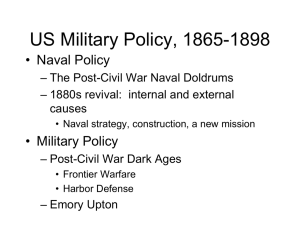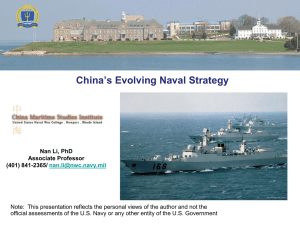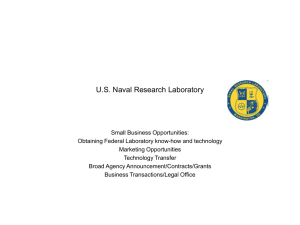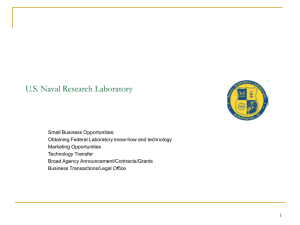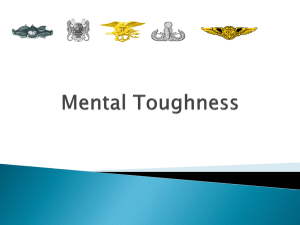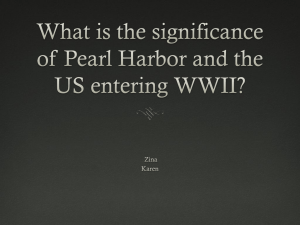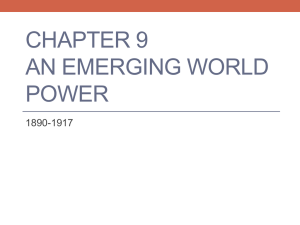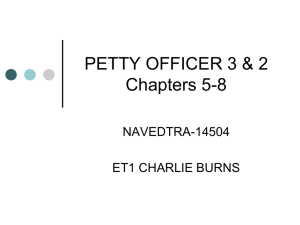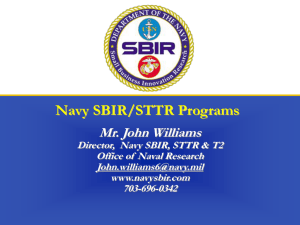9_WWI - Sea Power & Maritime Affairs
advertisement
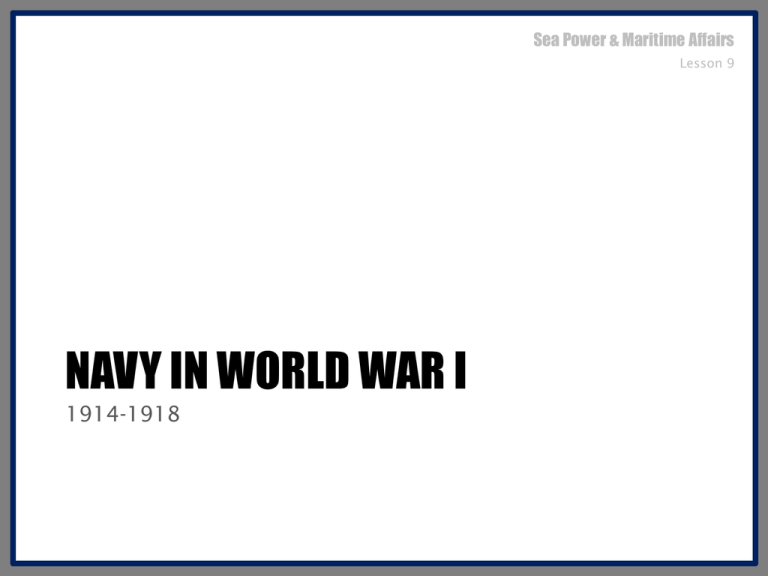
Sea Power & Maritime Affairs Lesson 9 NAVY IN WORLD WAR I 1914-1918 Admin Anything you want to include – Quizzes – Assignments – Etc Last Class 1898-1914 Spanish-American War Navy leading up to WWI – American expansionism – Roosevelt Corollary Today Navy in WWI Causes Naval war US involvement 8 Key Themes 1. 2. 3. 4. 5. 6. 7. 8. Navy as an instrument of foreign policy Interaction between Congress and Navy Interservice relations Technology Leadership Strategy & Tactics Evolution of US Naval Doctrine Future missions of Navy and USMC World War I 1914 – 1918 Gruesome War 70 million fight 9 million killed What you should know 1. Largely a land war 2. Sea strategies - Germany: Survival British: Pitt-style plan 3. Battle of Jutland (1916) - Lure GB into trap Only major fleet engagement Last major battleshipbattleship naval battle 4. German Desperation as war progresses - Unrestricted Sub Warfare 5. Why America entered war – – Unrestricted Sub Warfare Lusitania, Zimmerman Telegram, etc. 6. American naval strategy - Naval convoys over battleships 7. American naval contributions - Supply to Allied Powers Marines in Europe Videos WWI Video http://www.youtube.com/watch?v=gjlGoe 1mnw0&feature=related Overall Message World powers all poised for war. All have developed diverse and robust fleets that will fight in the most costly and universally advanced war in history. Expectations of Naval Battles Alfred Thayer Mahan • Big fleet v. Big fleet • Battleship v. Battleship • Long guns v. Long guns Torpedo attacks – Torpedo boats, Destroyers & submarines – Subservient to battleships Aviation as scout & possible torpedo boat Actual Naval Battles One major fleet engagement – Battle of Jutland (1916) Naval war fought by – Submarines (Germans) – Supply Convoy Escorts (Allies) Domino Effect to War 1. Assassination of Arch Duke Ferdinand 2. Austro-Hungarian empire declares war on Serbia 3. Russia declares war on AustroHungarian Empire 4. German declares war on Russia 5. France declares war on Germany 6. UK declares war on Germany 7. Japan declares war on Germany Where is US? Initial World Powers Involved Central Powers / Triple Alliance – – – – Germany Austria-Hungary Ottoman-Turks Italy Triple Entente (Allies) – UK – France – Russia Central Powers Army Strategy “Von Schliefen Plan” Objective: Minimize two-front war 1. Immediate invasion of France 2. Turn attention to Russia Allied Army Strategy 1. Block German Invasion in France 2. Invade Germany/Austria-Hungary/Italy from two fronts Initial Land Actions 1. Germany invasion of France is halted by French and British 2. Land battle becomes stalemate - Costly trench warfare Machine guns, artillery, mustard gas, shell shock. Germany realizes stalemate will lead to defeat - Begins unrestricted sub warfare against US merchants and passenger liners to stop allied supply. Central Powers Naval Strategy Conventional Warfare 1. Avoid superior British Fleet • Lure into sub ambushes 2. Destroy Allied Supply 3. Maintain own Freedom of Movement & Supply Allied Naval Strategy Return to “William Pitt” Style Warfare 1. Blockade German Navy in ports -German Fleet & Supply 2. Costal Raids 3. Maintain troop/supply transport corridor to continent 4. Maintain control of seas - Warships patrol sea lanes Initial Land Actions 1. Germany launches invasion of France 2. France slows it 3. Britain urgently sends troops to help France repel invasion. Reinforcements are successful stopping German advance. 4. Land battle reaches stalemate - Costly trench warfare No major movement on either side Germany realizes stalemate will lead to defeat and begins Unrestricted Sub Warfare against merchants and passenger liners Initial Naval Actions British begin blockade a. Declare North Sea as “War Zone” - Assert right to inspect and destroy ships carrying German war contraband b. Lay mine field in north sea c. Blockade German warships German Guerre de Course a. Surface ships at first b. Submarines afterwards Many built Initial Tactic: surface & inspect Engage in “Unrestricted Submarine Warfare” against any ship suspected of carrying contraband Sink over 5,234 Allied Ships before war’s end Almost defeat the allies with this alone Initial Naval Actions German v. British Fleets (1914-1916) a. Bigger British fleet keeps German navy in port. b. Limited success luring Brits into sub torpedo traps c. British get upper-hand is surface-to-surface engagements d. Germans get upper-hand in sub engagements e. Only major fleet engagement: Battle of Jutland (May 1916) - Indecisive battle - Last major battleship v. battleship battle. All subsequent major naval battles will be fought with air power. May 31, 1916 Battle of Jutland Why did the US Get Involved? War good for US so far 1. Booming economy 2. No fighting 3. Time to prepare for war • Naval Act of 1916 – Largest naval appropriations in history ($500 mil) – 60 capital ships by 1925 – 146 other vessels 4. Bargaining chip at end Why get involved? Why did the US get involved? 1. Unrestricted submarine warfare 2. Sinking of the Lusitania (1915) – 1,200 of 2,000 die 3. Zimmerman Telegram (1917) – Germany tries to recruit Mexico as ally 4. Make the world “safe for democracy” – Woodrow Wilson wanted negotiating power when war ended US Contribution At Sea – Supply, supply, supply • Submarine hunters • Convoy escorts • Merchant fleet – North sea mine barrage On land – Army and USMC tipped infantry scales in France – Army, Navy, USMC Aviation units What was the naval threat? Unrestricted submarine warfare Start of war, suspended, resumed in 1917 Germany initiated it against: – Any enemy merchant ship – Any ship suspected of carrying contraband – Nearly 5,000 merchant ships sunk What stopped it: – – – – Cruiser-destroyers Aircraft Submarine killer-hunters Mine fields Important People Asst. SECNAV Franklin Roosevelt SECNAV Josephus Daniels Important People ADM William Benson (1st Chief of Naval Operations) RADM William Sims (Naval Rep to Admiralty in London) “London Flagship” RADM William S. Sims – US Naval Rep to Admiralty – Learns UK is starving. Cannot survive much longer. Advocates for – Destroyers (not battleships) – Convoy system 1918 Atlantic Convoys Allied Shipping Losses US Enters War 1918 North Sea Mine Barrage 1918 Marines in Europe 70,000 Marines in France Belleau Wood / Teufel Hunden- “Devil Dog” What wins the war? (Not Russia) 1. Germany starving – Losing battle of attrition (supplies and men) 2. American entry tips scales – On sea and land What ends it? 1. Germans try one last offensive 2. Allies stop it and take offensive 3. Germany sues for peace before the terms will get worse End to War Armistice (Nov 11, 1918) – (11th min, 11th hour, 11th day in 1918) – Germany asked for it Treaty of Versailles (1919) – Army laid down weapons – Navy: Scapa Flow What did we learn from WWI? Technology? Strategy or tactics? Balance of Sea power? Next Class Topic Assignment(s) Quiz Other Info Inter-War Navy (1918-1939)
